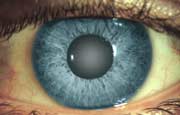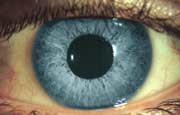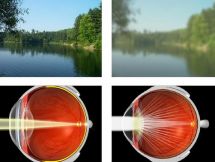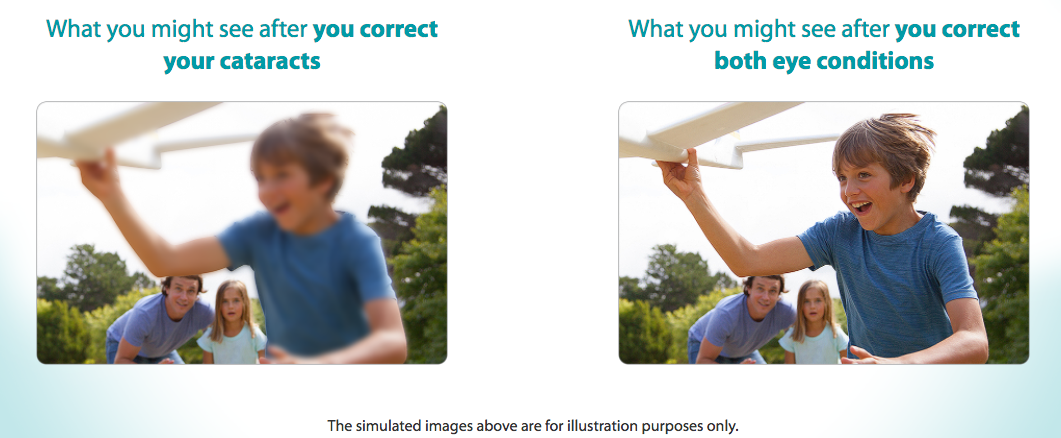We have many types of vision. Some parts of our eyes help us see things to the right and left, others help with distinguishing colors and seeing at night. The macula is the part of the eye which affects our ability to read and to see fine detail.
Macular Degeneration is a disease characterized by the blind spot in the central vision. People with Macular Degeneration find it difficult or impossible to read, recognize faces, see clearly at long distances or distinguish different colors. Some forms of Macular Degeneration are hereditary and can affect people of all ages. Other types are caused by disease or injury. The most common form of the disease is part of the aging process and usually affects both eyes. Macular Degeneration is the leading cause of severe visual loss among prople age 65 and older.
Why is the macula so important?
The nerve tissue that lines the inside of the eye is called the retina. The retina is the part of the eye that senses light and then relays a signal to your brain where seeing actually takes place. In the middle of the retina, directly behind the pupil of the eye, is a circular area about one-fifth of an inch across. This is called the macula. The macula is the part of the retina which is responsible for sharp, central vision.
What happens in macular degeneration?
In Macular Degeneration, the macula loses its ability to function efficiently. One form of the disease involves the breakdown of the thin layer which separates the macula from underlying blood vessels. New, abnormal blood vessels grow and bleed or leak fluid into the macula. Visual cells in the affected area sicken and die.
What can be done?
Any person who experiences a loss of central vision or begins to see straight lines as wavy or crooked should contact their ophthalmologist/Eye M.D. immediately.
Between eye examinations, people with early signs of Macular Degeneration may be advised to use an Amsler Grid supplied by their ophthalmologist/Eye M.D. to check their eyes at home. This is a grid of crossed lines. If a person's macula is normal, the lines appear straight. If new blood vessels are growing and leaking fluid into the macula, some of the lines may appear curved, wavy, or may not be visible at all.
Patients who use the grid should look at it regularly and contact their ophthalmologist/Eye M.D. immediately if they notice any changes in its appearance.
If Macular Degeneration is caused by abnormal vessels leaking into the macula, the condition may be treated with laser therapy. The laser is an intense ray of light which is focused on a tiny spot on the retina. The light produces heat which is used to seal off the troublesome vessels. This can prevent further leakage and tissue destruction. Laser theraphy is often performed in the ophthalmologist/Eye M.D.'s office.
People affected by Macular Degeneration also may find optical devices, sometimes called low vision aids helpful. Your eye care specialist can tell you more about the types of devices available.
Glaucoma is a leading cause of blindness among adults in the United States. About two million Americans have glaucoma, and half of them don't even know it. That's because glaucoma often has no symptoms. Vision loss from glaucoma can be prevented by early detection and proper treatment.
There are several kinds of glaucoma, and they are all caused by an increase in the amount of fluid inside the eye. Increased fluid causes a build-up of pressure in the eye. At first, this increased pressure damages only those parts of the eye which enable you to see on each side. In the final stages of the disease, the nerves that permit front vision are damaged, and all sight is gone.
The most common kind of glaucoma is called chronic glaucoma. It is a slowly developing condition that can rob victims of their sight without causing any symptoms at all. Glaucoma also may be present at birth or be caused by some other eye problem. In some cases it comes on suddenly with very noticeable symptoms.
There are several kinds of glaucoma, and they are all caused by an increase in the amount of fluid inside the eye. Increased fluid causes a build-up of pressure in the eye. At first, this increased pressure damages only those parts of the eye which enable you to see on each side. In the final stages of the disease, the nerves that permit front vision are damaged, and all sight is gone.
The most common kind of glaucoma is called chronic glaucoma. It is a slowly developing condition that can rob victims of their sight without causing any symptoms at all. Glaucoma also may be present at birth or be caused by some other eye problem. In some cases it comes on suddenly with very noticeable symptoms.
Who can get glaucoma?
Glaucoma often runs in families. People with a relative who had the disease are more likely to get it. The disease usually does not develop before the age of 35. The chance of getting glaucoma increases with age. People who are very nearsighted, farsighted or who have diabetes are more likely to develop glaucoma. It's also more common among black people than white people, and among people with high blood pressure.
How do we find out if you have glaucoma?
Your eye pressures are checked and the eye nerve is examined. Special tests are done to find out if your nerve has been damaged. The most reliable tests are now the OCT Scanner and the Nerve Fiber Analyzer - GDx (both quick and painless tests) available in our office. The older Visual Fields test, along with the OCT Scanner and Nerve Fiber Analyzer give us a very clear idea of whether or not you have glaucoma.
How is glaucoma treated?
If glaucoma is detected in its early stages, it usually can be controlled with eye drops or medication. Laser surgery often is used and can be very effective in decreasing eye pressure to an acceptable level. In some cases, other types of surgery may be recommended to prevent pressure build-up. Patients with glaucoma must follow their eye physician's orders carefully. Treatment must be followed for life, and periodic re-examinations are very important.
What should you do?
Since most people with glaucoma have no symptoms, the key to preventing vision loss is regular examinations by an eye professional. There is a quick, painless test for glaucoma that can be done as part of a routine eye exam. Eye examinations are recommended every two years, or every year if there are other members of your family who have glaucoma.
In addition, if you experience loss of side vision, difficulty adjusting to dark rooms, blurred vision or frequent need for new glasses, you should contact an ophthalmologist/Eye M.D. immediately. The appearance of halos or rainbows around lights are also warning signs.
Don't wait for symptoms.A routine eye examination could save your vision.
Diabetes is a complex disease which can affect nearly every tissue of the body, including the tiny blood vessels in the eyes. About 40 percent of people with diabetes have some signs of disease-related eye problems. About 3 percent suffer severe visual loss because of diabetes.
What eye problems can diabetes cause?
No one knows exactly how diabetes damages the eyes, but diabetics are more likely than other people to develop a number of visual disorders. This is especially true for people who have had diabetes five years or longer. One of the milder, often temporary effects of diabetes is a change in the focusing power of the eye. Eyeglasses or contact lenses might suddenly seem to be too strong or too weak. Diabetes may also lead to cataracts and glaucoma.
The most important and most common cause of visual impairment in diabetics is Diabetic Retinopathy. This is a condition which affects the retina, the seeing part of the eye.
What is Diabetic Retinopathy?
Diabetic Retinopathy is the breakdown of small blood vessels that nourish the retina. When these blood vessels become damaged by diabetes, they can no longer supply all the oxygen and nutrients the retina needs to remain healthy. The blood vessels may begin to bulge out, leak fluid, bleed, grow abnormally or close up completely. The longer a person has diabetes, the greater the risk of retinopathy. It may interfere with vision during the first 5-10 years of diabetes. About 60 percent of people who have diabetes for more than 15 years have some degree of damage to the blood vessels of the eye.
How serious is the disease?
A person who has had diabetes for several years may begin to develop tiny bulges in the walls of the retina's blood vessels. Fluid may leak from the vessels and deposits of fat may form. This is called background retinopathy, and usually has no symptoms unless the leakage occurs in the center of vision called the macula. In this case, vision may be slightly decreased and later progress to more severe impairment.
Another problem that affects the retina is proliferative retinopathy. New blood vessels begin to form in and around the retina. Scar tissue may form and block out light. The new vessels may bleed into the eye. The person may experience cloudy vision or see cobwebs in the eye. If the retina itself becomes detached, the results may be serious loss of vision or blindness.
What can be done?
The treatment most commonly used for Diabetic Retinopathy is laser photocoagulation. An intense beam of laser light energy is used to seal off leaking blood vessels and to control or prevent the growth of new, abnormal blood vessels. This painless treatment is done with a laser in the ophthalmologist/Eye M.D.'s office.
If abnormal blood vessel growth is severe or bleeding continues to be a problem, a procedure called vitrectomy may be recommended.
The ophthalmologist/Eye M.D. uses special surgical instruments to remove the blood and scar tissue from the clear fluid in the center of the eye called the vitreous. About 50 percent of patients who have a vitrectomy operation have improved vision.
What should you do?
If you have diabetes, you should have your eyes examined by an eye professional at least once a year. You should consult an ophthalmologist/Eye M.D. immediately if you suddenly lose vision, or if you experience any unusual visual sensations. It is also very important to work with your physician to keep your diabetes under control.
Cataract surgery is considered one of the safest surgical procedures in the US.

Eye with cataract |

Normal eye |
A cataract is a clouding of the eye's lens which causes vision problems. Usually cataracts are related to aging. Over half of all Americans over age 65 have a cataract.
The lens of the eye is made to let light pass through and focus on the retina, and is made up of water and protein. Sometimes as we age some of the protein will clump together making small cloudy areas on the lens. These cloudy areas or cataracts interfere with vision by preventing the light from reaching the retina.
As time passes, the cataract may grow, making it harder to see. Vision through cataracts becomes dull and blurry, and cataract removal surgery becomes necessary.
There is no known cause for cataracts at this time.
The most common symptoms of cataracts are:
- Cloudy, dull or blurry vision
- Glare from light such as bright sunlight
- Seeing halos around lights such as headlights
- Double vision
- Colors that seem dull or faded
- Poor night vision
These or other changes in your vision can be a sign not only of cataracts, but other eye problems as well.
If you have any of these symptoms, please call Mid Atlantic Eye Physicians and our team of Eye M.D.'s (Ophthalmologist) will be ready to talk with you.
Cataract Surgery
 A cataract is a clouding of the eye's lens which causes vision problems. Usually cataracts are related to aging. Over half of all Americans over age 65 have a cataract. There is no known prevention for cataracts, but fortunately cataract surgery is one of the safest and most successful procedures performed today, improving vision in over 98% of cases in which surgery is recommended.
A cataract is a clouding of the eye's lens which causes vision problems. Usually cataracts are related to aging. Over half of all Americans over age 65 have a cataract. There is no known prevention for cataracts, but fortunately cataract surgery is one of the safest and most successful procedures performed today, improving vision in over 98% of cases in which surgery is recommended.
Cataract surgery has experienced tremendous advancements over recent years, and Mid-Atlantic Eye Physicians has kept the pace. This sight restoring procedure has provided a higher quality of life for many patients who used to suffer from poor vision as a result of cataracts.
Older, more conventional methods of cataract surgery use a large incision to remove cataracts. The small incision surgery utilized by Dr. Crichlow allows the incision to heal naturally with no stitches.
Among the many advantages of small incision cataract surgery over the older type of surgery are:
- Faster healing time allows you to return to normal activities sooner.
- If glasses are needed after surgery, they can be fitted sooner
- Vision is usually better right after the surgery is finished, or within 24 hours
- Less astigmatism
Dr. Crichlow performs cataract surgery on an out-patient basis at these local hospitals: Halifax Regional Medical Center in Roanoke Rapids, NC and VCU Health Community Memorial Hospital in South Hill, VA
Take control of your vision
Believe it or not, there has never been a better time to have cataract surgery. Today, patients can choose from a wide variety of replacement lenses - and the results can be extraordinary. Depending on the lens you choose, you could have clear, sharp vision with little to no need for corrective eyewear in some instances.
Which lens is right for me?
Monofocal Lenses
Monofocal lenses have a single focal point for clear distance vision. However, while distance vision is usually improved, most patients still need to wear glasses for up-close tasks, like reading or working at a computer.
Astigmatism-Correcting Lenses
These types of lenses, such as Acrysof IQ Toric IOL, are specifically designed for patients with astigmatism. Similar to a monodical IOL, these lenses offer much improved distance vision, though patients will usually still require glasses for near-vision activities.
Multifocal Lenses
Multifocal lenses, like the AcrySof IQU ReSTOR are designed to provide a full range of clear, sharp vision. These lenses restore cataract-impaired vision and can correct for nearsightedness, farsightedness, and presbyopia.

At Mid Atlantic Eye Physicians, our caring staff will help you determine which lenses is right for you based on your eyes, your visual needs and your lifestyle. Feel free to ask as many questions as you like. Click Here to contact us!




 A cataract is a clouding of the eye's lens which causes vision problems. Usually cataracts are related to aging. Over half of all Americans over age 65 have a cataract. There is no known prevention for cataracts, but fortunately cataract surgery is one of the safest and most successful procedures performed today, improving vision in over 98% of cases in which surgery is recommended.
A cataract is a clouding of the eye's lens which causes vision problems. Usually cataracts are related to aging. Over half of all Americans over age 65 have a cataract. There is no known prevention for cataracts, but fortunately cataract surgery is one of the safest and most successful procedures performed today, improving vision in over 98% of cases in which surgery is recommended.